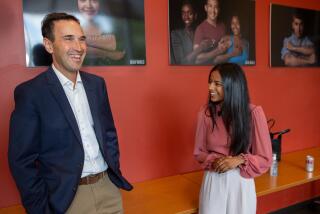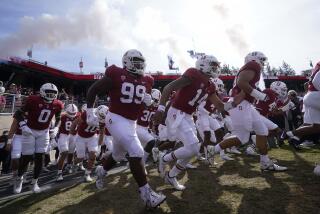Seattle Schools Mourn Their Hero
- Share via
SEATTLE — John Stanford loved to shake up the status quo, and when he signed on three years ago as superintendent of Seattle schools, he found he could do it with just a hallway greeting.
“Hi, John, how are you?” people would say.
“Perfect and improving,” came his standard reply.
He’d say it with a smile, and everyone would laugh--only to discover later, when they got to know him, that he wasn’t joking at all.
“He meant it,” says Barbara Schaad-Lamphere, Seattle school board president. “That’s John Stanford. Things are great, and they can always get better.”
This week Seattle mourned the loss of a civic leader who exemplified the power of positive thinking. Stanford died of leukemia a week ago.
His indomitable spirit worked for him all his 60 years, helping Stanford win one improbable victory after another. His parents never finished grade school, but Stanford earned a master’s degree and became a two-star Army general. As a retired military man with no background in school administration, he brought hope to Seattle’s troubled school system.
Last spring, when doctors told him that the odds of surviving his cancer were slim, he knew immediately what to do: fight.
Ultimately, the cancer won. But in waging his final battle, Stanford achieved his most improbable victory yet. Weakened by disease, turned bald and gaunt from chemotherapy, he discovered an even wider audience for the message he’d always preached to Seattle’s children: Dream big. Work hard. Above all, never give up.
John Henry Stanford grew up in the Philadelphia suburb of Yeadon. His father worked in a steel mill and his mother was a restaurant cook, but they nurtured loftier dreams for young John and his two sisters.
Stanford quickly met their expectations. One of just a few black students in a mostly white high school, he was voted class president. He earned a bachelor’s degree in political science from Pennsylvania State University and then joined the Army.
His “love ‘em and lead ‘em” philosophy, along with distinguished service as a pilot and battalion commander in Vietnam, propelled Stanford to the military’s highest echelons. During his 30-year career, he served as executive assistant to two defense secretaries and oversaw transportation planning for Operation Desert Storm--all while raising two sons, Steven and Scott, with his wife, Patricia.
Retiring in 1991, he hired on as manager of Georgia’s Fulton County, where he was lauded as a bureaucracy buster who restored public confidence in county government.
He started work as Seattle school superintendent in August 1995, recruited by a school board anxious for change. Test scores were low. So was teacher morale. Parents feared for their children’s safety. “White flight” to private schools was draining the public system of both students and hope.
“We needed a spark,” Schaad-Lamphere said. “We didn’t know we were getting a blowtorch.”
Stanford declared himself “the children’s czar” and became one of Seattle’s most visible civic leaders. The motto at school district headquarters, “All Children Can Learn,” was replaced by “All Children Will Learn.” Stanford led a citywide reading campaign, exhorting every adult to read for 30 minutes a day to a child. He raised performance standards and tightened campus security.
Results soon started showing: The dropout rate declined. SAT scores rose. Enrollment increased. Less quantifiable but undeniable, a sense of hope crept back into Seattle’s schools.
Tall and trim, with a laser-lock gaze and a voice that rang with a passion for education, Stanford transformed public perceptions by virtue of his own prism on reality. In John Stanford’s world, Seattle’s schools were perfect and improving, and his optimism was infectious.
Parents started volunteering more. Businesses donated more time and money. Seattle residents started describing Stanford as a visionary.
“Such quasi-religious admiration gets to be a little much,” a Seattle Times editorial complained, then delivered its own tribute:
“Stanford seizes ownership of old truths and forces people to hush up and remember them. That skill enables him to stand on a balcony and say we should never, ever give up on a child, and several hundred people will hear it as Stanford’s latest brilliant idea. It is the genius of charisma, steeled by sincerity.”
By last winter, Stanford was at the top of his game--except for that troublesome cough and fever.
The diagnosis came in early April: acute myelogenous leukemia, a form of blood cancer in which abnormal white blood cells crowd out healthy cells. Untreated, the disease could kill him in just three months, doctors said. With chemotherapy, there was a 70% possibility of knocking the cancer into remission, but only a 1 in 4 chance of complete recovery.
Stanford responded, as usual, with defiant optimism.
“I’m not angry, I’m not bitter, I’m not saying, ‘Why me, God?’ ” Stanford told the Seattle Post-Intelligencer. “I’m saying, I have this illness and I can defeat it.”
His hair fell out. He lost 15 pounds. But the chemotherapy seemed to work, and Stanford was released from the hospital May 8, saying he was strong and ready to resume his duties.
Three weeks later, though, he was back in the hospital for more chemotherapy, followed by a stem-cell transplant from his sister, Carolyn Stanford Adams.
By September, he felt well enough to make a surprise appearance at a back-to-school rally. Back on the job, Stanford was walking up to four miles a day and dishing out inspirational words to all comers: Oprah, “NBC Nightly News,” The New York Times.
In mid-October, doctors found fresh traces of leukemia--an ominous sign so soon after treatment.
As Stanford headed back to the hospital and spread the grim news to family and friends, he tried to cheer them up. He marveled at the luck of falling ill in Seattle, where there is a major cancer-research institute.
“It’s going to be great,” he told Schaad-Lamphere. “This is John Stanford. I won’t quit. I am not a quitter.”
Now, however, Stanford started keeping a lower profile. Doctors were under orders not to divulge details of his treatment. His contact with school officials dropped to its lowest in months.
If his can-do attitude had been a public facade, he could now safely drop it. But he did no such thing, even when maintaining it grew more painful. Carolyn said she would call the hospital one day and hear her brother’s strong, spirited voice. The next day, he’d be too tired to answer.
Two weeks ago, he called district spokesman Trevor Neilson to his hospital room to discuss school business, including a January event for school supporters. Stanford talked about it as if he planned to be there.
In a way, he will be.
“Read On For John” declares a sign in the window of a west Seattle home. Parents, teachers and children this week embraced and wept and shared stories about Stanford. And they vowed to remember a man who died as he had lived: perfect and improving.
More to Read
Sign up for Essential California
The most important California stories and recommendations in your inbox every morning.
You may occasionally receive promotional content from the Los Angeles Times.













